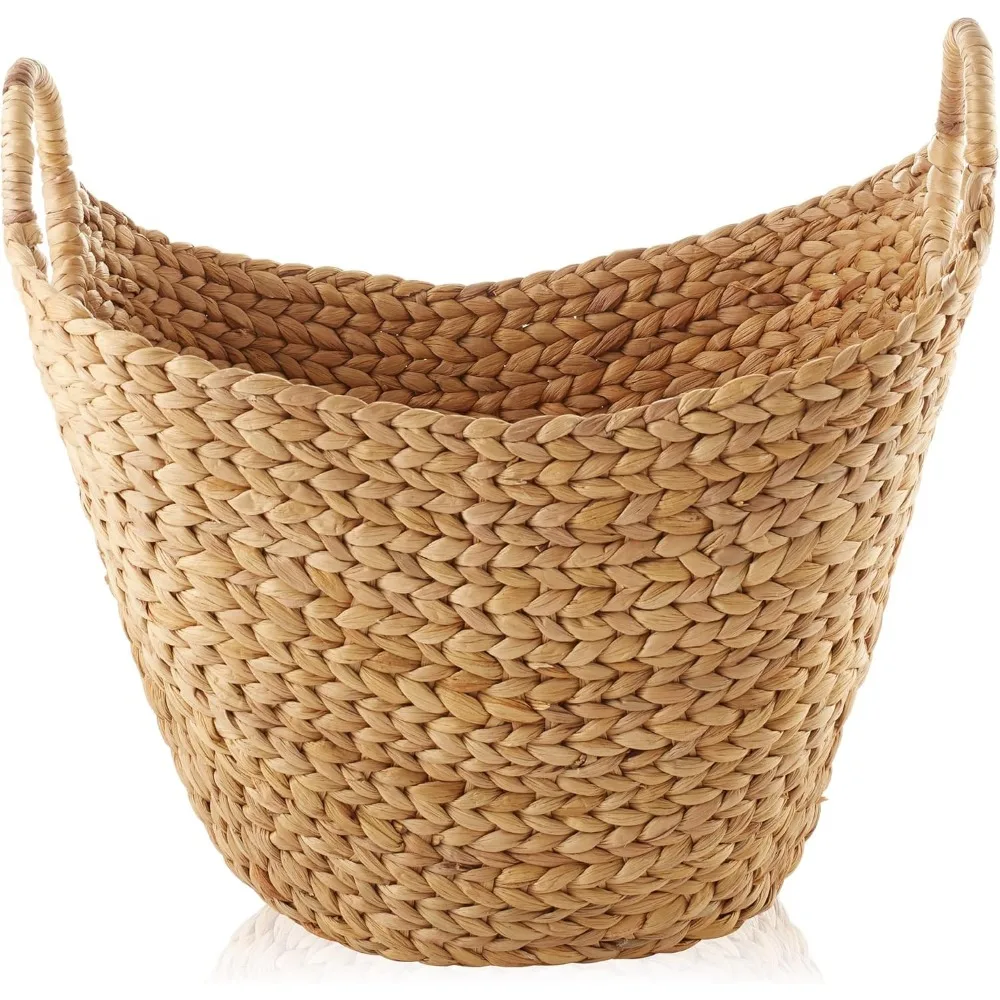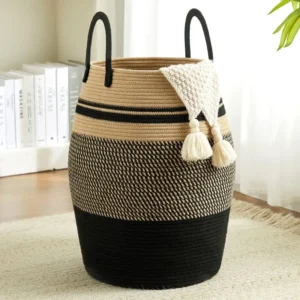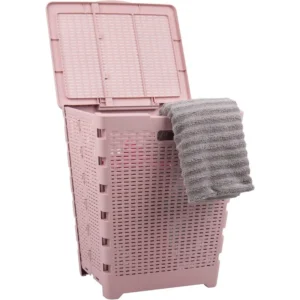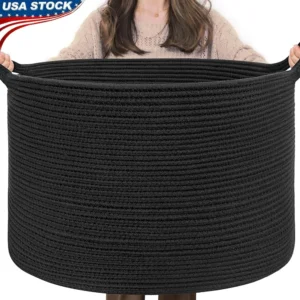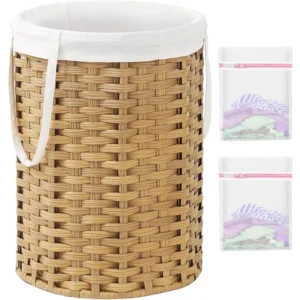The Natural Appeal of Wicker & Woven Baskets in Laundry Spaces
Wicker and woven baskets bring an instant touch of warmth and natural texture to laundry spaces. While often used interchangeably, these terms refer to slightly different things: wicker describes the technique of weaving flexible materials, while the baskets themselves can be made from various natural fibers including rattan (a climbing palm), seagrass, water hyacinth, and jute. Each material offers unique characteristics in terms of durability, flexibility, and visual appeal, making them perfect additions to functional spaces.
The beauty of these natural elements lies in their ability to transform purely utilitarian rooms into inviting areas of the home. Laundry rooms typically feature hard surfaces, mechanical appliances, and clinical aesthetics. The fundamental understanding of basket materials reveals why introducing organic textures through woven baskets creates visual balance while serving practical purposes.
These versatile storage solutions bridge the gap between form and function—a rarity in home organization. Unlike plastic alternatives that prioritize function over aesthetics, wicker and woven baskets deliver equal measures of both. They offer:
- Natural texture that softens industrial-feeling spaces
- Visual warmth through organic materials and earthy tones
- Character and craftsmanship that mass-produced items lack
- Timelessness that transcends passing design trends
- Versatility to complement various decor styles
The use of baskets for laundry is far from new—traditional laundry baskets have been woven for centuries. However, today’s focus on elevating every space in the home has brought renewed attention to these practical items. Studies suggest that organized, aesthetically pleasing spaces reduce stress and improve productivity, making the consideration of wicker vs woven baskets an important part of creating a more pleasant laundry routine.
Key Benefits: Why Wicker & Woven Baskets Excel in Laundry Organization
Breathability stands as perhaps the most significant advantage these baskets offer in laundry settings. Unlike solid plastic containers, the natural weave creates spaces between fibers that promote air circulation—crucial for both clean and soiled garments. This ventilation helps prevent the musty odors that can develop when damp items remain in enclosed spaces and allows slightly damp clean laundry to continue drying.
Quality wicker and woven products offer impressive durability when properly maintained. While the initial investment may exceed that of plastic alternatives, well-crafted natural fiber baskets can last for years or even decades. Their flexibility allows them to absorb impact without cracking or breaking, and many natural fibers actually strengthen with age as they develop a patina.
The versatility of these baskets makes them ideal for numerous laundry room applications:
* Sorting dirty clothes by color, fabric type, or family member
* Transporting clean laundry to bedrooms for folding and storage
* Containing cleaning supplies, dryer sheets, and detergents
* Displaying neatly folded towels or linens on open shelving
* Storing specialty items like delicates bags or clothespins
Texture plays a crucial role in interior design, and laundry rooms—often dominated by smooth surfaces like appliances and countertops—benefit tremendously from the visual and tactile contrast woven baskets provide. The natural variations in fiber, weave pattern, and color add warmth and character to spaces that might otherwise feel sterile or purely functional.
From a sustainability perspective, baskets made from renewable plant fibers represent a more environmentally responsible choice than petroleum-based plastics. Many benefits of woven wicker laundry baskets extend beyond their immediate utility to include biodegradability at the end of their useful life and support for traditional crafting methods that have sustained communities for generations.
These natural elements complement virtually any design aesthetic. In farmhouse-style laundry rooms, they enhance the rustic, lived-in feel. In modern spaces, they introduce organic contrast to sleek lines and minimalist elements. Coastal decor benefits from their beach-inspired textures, while bohemian styles embrace their artisanal quality.
Essential Basket Types for Complete Laundry Room Organization
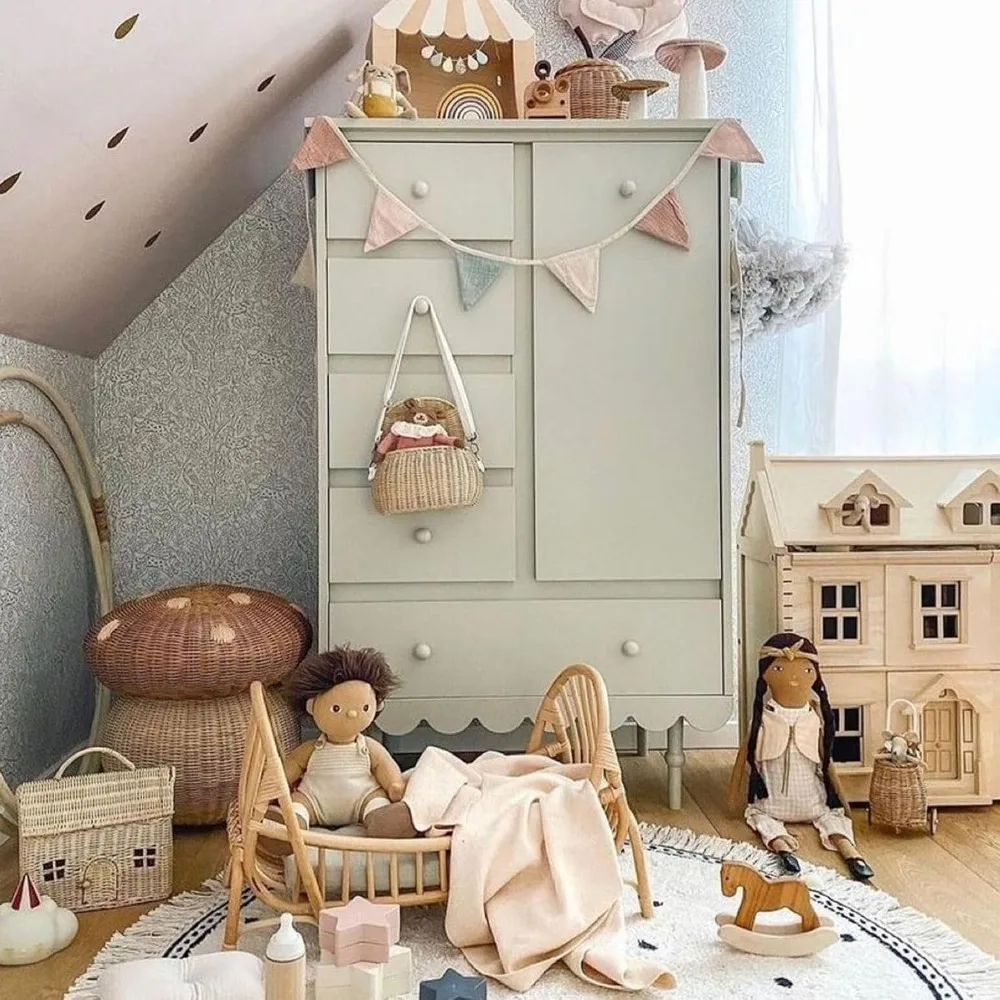
Large Hampers and Sorters
The workhorses of laundry organization, large woven hampers provide ample capacity for collecting dirty clothes between wash days. These substantial baskets come in various configurations to meet different household needs:
- Single compartment designs for simple collection
- Divided sorters with 2-3 sections for pre-sorting lights, darks, and delicates
- Stackable options that maximize vertical space in tight quarters
- Rolling hampers with handles for easy transport to and from the washing machine
When selecting from available wicker laundry hampers, consider capacity needs based on your household size and laundry frequency. Most family homes benefit from hampers that can hold 2-3 loads of laundry, typically measuring 18-24 inches in height with proportional width and depth.
Medium Storage Baskets
Mid-sized baskets serve as perfect containers for laundry supplies and frequently accessed items. Typically ranging from 12-16 inches in diameter or width, these versatile baskets can hold:
- Detergent bottles and fabric softeners
- Stain removal products
- Dryer sheets and wool dryer balls
- Small tools like lint brushes and clothing shavers
- Ironing supplies and spray bottles
The medium size category within woven laundry baskets offers the greatest versatility, with options including rectangular shapes for shelf storage, round designs for countertops, and handled varieties for easy transport between storage and use locations.
Small Organizational Baskets
Smaller baskets measuring roughly 6-10 inches provide perfect containment for easily misplaced items and specialty supplies:
- Lost socks awaiting matches
- Clothespins and small hanging clips
- Safety pins and garment repair supplies
- Delicates bags and lingerie wash bags
- Loose change and items found in pockets
These compact organizers maximize efficiency by keeping small items visible and accessible rather than buried in drawers or larger containers.
Specialty Baskets
Certain laundry organization needs call for specialized basket designs:
- Foldable or collapsible options for occasional use or limited storage
- Lined baskets with washable fabric interiors for protecting delicate items
- Wall-mounted or hanging systems that free up floor and counter space
- Lidded designs that conceal contents for a neater appearance
- Nested sets that can be expanded or condensed as needs change
Each specialty type addresses specific organizational challenges while maintaining the aesthetic benefits of natural materials.
Practical Applications: Strategic Basket Placement in Your Laundry Room
Creating an efficient laundry workflow begins with thoughtful basket placement. Position your primary hamper or sorting system near the washer for minimal movement when transferring clothes. For multi-level homes, consider smaller collection baskets in bedrooms or bathrooms that feed into your main sorting system.
The washer/dryer zone benefits from specific basket assignments:
* A medium basket atop the dryer for holding clean, hot items awaiting folding
* A small container for lint collection positioned within arm’s reach
* A designated hamper for items requiring special treatment (hand washing, line drying)
* A narrow basket between machines for holding dryer sheets and wool dryer balls
Creating effective sorting stations transforms the laundry process. Consider dividing dirty laundry into categories that match your washing habits rather than traditional whites/colors/darks divisions. For some households, sorting by water temperature or fabric type makes more sense. Effortless laundry organization with wicker baskets comes from systems tailored to your specific routines.
Shelving and cabinet integration allows baskets to function as pull-out drawers without the expense of custom cabinetry:
* Use rectangular baskets sized to fit standard cabinet widths
* Position frequently accessed items in baskets at eye level
* Reserve lower shelves for heavier baskets containing bulk supplies
* Implement basket labels for family members to maintain the system
Counter and surface organization benefits from containment strategies:
* Group similar items (stain removers, specialty detergents) in designated baskets
* Use handled baskets for items that move between locations
* Position frequently used supplies in open baskets and occasional items in lidded options
* Elevate some baskets on risers to create visual interest and improve visibility
Vertical space utilization maximizes efficiency in compact laundry rooms:
* Install floating shelves with appropriately sized basket inserts
* Consider wall-mounted basket systems designed specifically for vertical storage
* Use stacking baskets with stable bases when floor space is limited
* Implement over-door hanging organizers with basket inserts for supplies
Material Selection Guide: Choosing the Right Basket for Your Needs
| Material | Durability | Moisture Resistance | Visual Appeal | Ideal Laundry Use |
|---|---|---|---|---|
| Rattan | High | Moderate | Rich, natural | Hampers, display baskets |
| Seagrass | Medium-high | High | Textured, variegated | Supply storage, dry goods |
| Water Hyacinth | Medium | Very high | Chunky, substantial | Damp item storage |
| Jute | Medium | Low | Rustic, earthy | Dry storage only |
| Cotton Rope | Medium | High (washable) | Soft, casual | Liner baskets, small items |
| Resin Wicker | Very high | Excellent | Consistent, weather-resistant | Humid environments |
Rattan stands as the premium choice for wicker baskets, offering exceptional durability and a rich, warm appearance. This climbing palm material features a solid core with natural flexibility, allowing it to be woven into sturdy constructions that maintain their shape for years. While not completely waterproof, quality rattan laundry baskets handle the humidity of laundry environments well when properly maintained. Their higher price point reflects their durability and classic aesthetic.
Seagrass provides excellent strength with distinctive texture variations. The natural colors range from pale green to golden tan, developing a beautiful patina over time. Its tight weave creates sturdy containers ideal for storing folded linens or laundry supplies, though it may not be ideal for damp items as extended moisture exposure can eventually cause weakening.
Water hyacinth, harvested from aquatic plants, offers exceptional moisture resistance making it perfect for laundry room environments. Its chunky, substantial weave creates visually striking baskets with excellent stability. These baskets handle humidity particularly well, making them suitable for bathrooms and laundry areas where moisture levels fluctuate.
For those seeking weather-resistant options that mimic natural materials, resin wicker provides durability in extremely humid conditions. This synthetic alternative maintains the look of natural fibers but withstands moisture, making it practical for laundry rooms in particularly damp climates or basement settings. Understanding how to clean wicker baskets properly will extend the life of any material choice.
Design Integration: Coordinating Baskets with Your Laundry Room Style
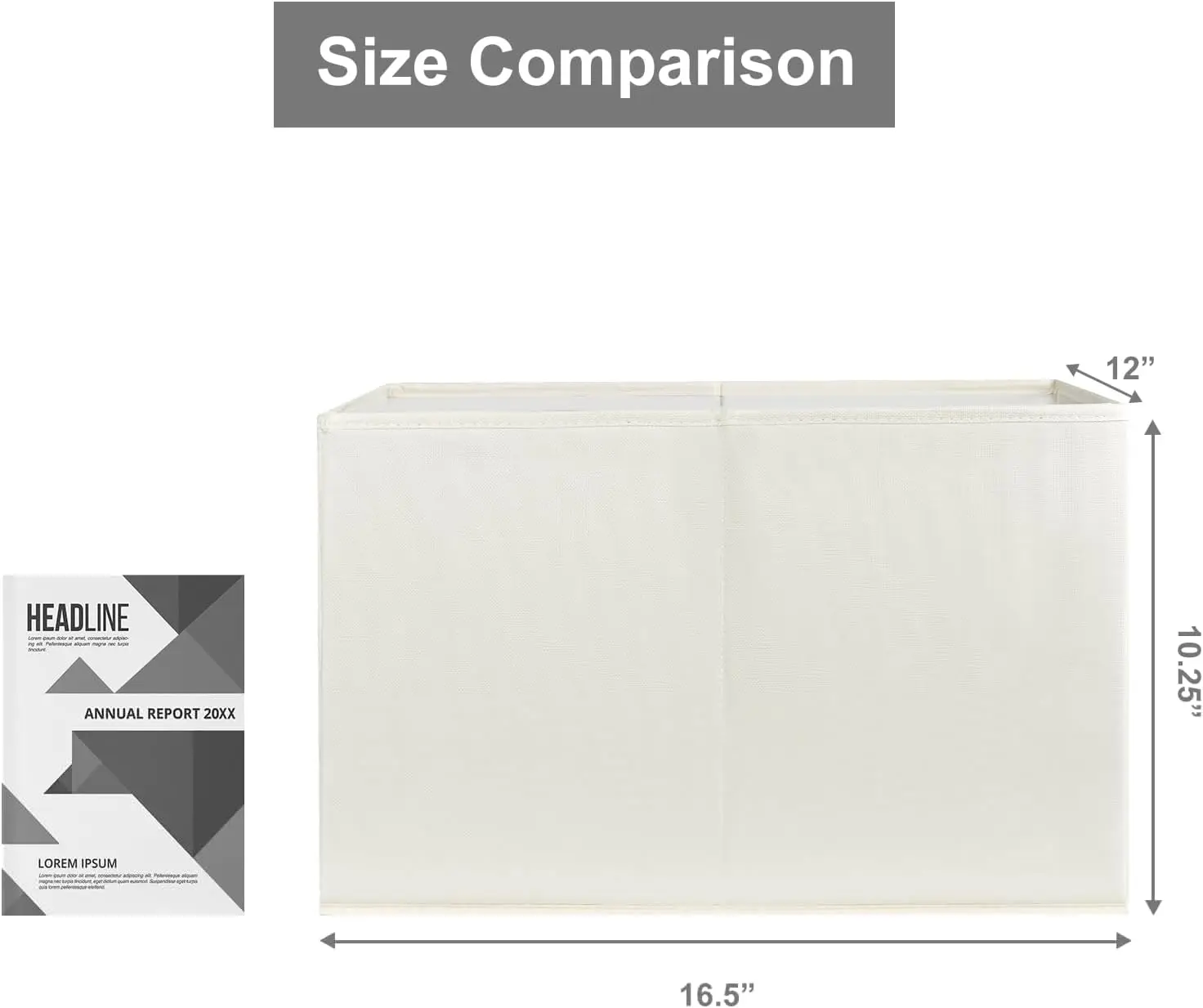
Creating visual cohesion begins with thoughtful color selection. Natural fiber baskets typically feature earthy neutrals that complement virtually any color scheme. For contemporary spaces, look for baskets in their natural state, showcasing the inherent beauty of the materials. Traditional or country-inspired laundry rooms might incorporate white-washed or painted wicker for a softer effect. Bold laundry spaces can feature dyed natural fibers in statement colors that accent wall colors or textiles.
Mixing different basket types creates visual interest while maintaining functional organization. The key lies in finding a unifying element—whether consistent color tones, similar weaving patterns, or complementary shapes. A successful mix might include:
* Large seagrass hampers for dirty laundry collection
* Medium water hyacinth baskets for supplies
* Small rattan containers for miscellaneous items
These varied textures create dimension while serving specific purposes.
Coordinating with existing finishes involves identifying complementary tones. Woven baskets pair beautifully with virtually any laundry room material:
* With white appliances, natural tones add warmth and prevent a sterile appearance
* Alongside stainless steel, they introduce organic balance to metallic surfaces
* With wood cabinetry, select weaves that complement rather than match exactly
* Against colorful walls, neutral baskets provide visual breathing space
Creating a unified aesthetic doesn’t require matching pieces. Instead, the differences between wicker and woven laundry baskets can be leveraged to create a curated collection. Consider establishing a “basket palette” of 2-3 compatible materials or tones that work together throughout the space. This approach creates cohesion while avoiding monotony.
Size & Proportion: Selecting the Perfect Basket Dimensions
Selecting appropriately sized baskets begins with measuring your available space and understanding your specific storage needs. As a general guideline:
For small laundry rooms (under 50 square feet):
* Prioritize vertical storage with stacking baskets
* Choose slimmer profile hampers (12-14 inches deep) that won’t obstruct movement
* Select baskets no more than 2/3 the width of available shelving
* Consider collapsible options for occasional use items
For medium laundry rooms (50-100 square feet):
* Balance floor-standing and shelf-stored baskets
* Allow 18-24 inches of hamper width for comfortable access
* Ensure at least 12 inches of clearance above baskets for easy retrieval
* Layer baskets of decreasing size on countertops (largest at back)
For large laundry rooms (over 100 square feet):
* Incorporate statement pieces like oversized hampers or decorative displays
* Create dedicated zones with appropriate basket sizes for each function
* Allow for negative space between baskets for visual breathing room
* Consider the visual weight of larger baskets and distribute evenly
Proportional relationships between baskets and other elements create visual harmony. Laundry baskets should generally not exceed the height of a front-loading washer or the depth of standard countertops. Our collection of large wicker laundry baskets provides options suited to spacious laundry rooms while maintaining proper scale.
When determining capacity needs, consider your household’s laundry volume. A typical hamper should hold approximately two loads of laundry, while supply baskets should accommodate your regular products with 20% extra space for occasional items or new purchases.
Maintenance & Care: Keeping Your Woven Baskets Beautiful
Maintaining woven baskets in laundry environments requires attention to moisture management. Regular dusting with a soft brush prevents buildup in the weave pattern, while occasional vacuuming with an upholstery attachment removes deeper debris. For cleaning:
- Natural fiber baskets: Wipe with a barely damp cloth and dry immediately
- Cotton rope baskets: Many can be machine washed on gentle cycles
- Synthetic wicker: Can be cleaned with mild soap and water, then air dried
In humid laundry rooms, proper air circulation prevents mold and mildew. Position baskets with slight spacing between them and the wall. Avoid placing damp items directly in unsealed natural fiber baskets without a liner. If moisture issues persist, consider:
- Rotating baskets to different locations periodically
- Using a dehumidifier in particularly damp environments
- Selecting water hyacinth or synthetic options for the most humid areas
Minor repairs extend basket lifespan significantly. Keep unraveling in check by tucking loose ends back into the weave or securing with a tiny dot of clear craft glue. For structural issues, wooden skewers can reinforce weakened areas from the inside without visible repair marks.
With proper care, quality woven baskets often last 5-10 years, making them a sustainable and economical choice for laundry organization.
Sustainable & Eco-Friendly Options: Making Responsible Choices
Natural fiber baskets represent a renewable alternative to plastic storage solutions, offering significant environmental benefits. These materials—rattan, seagrass, water hyacinth, and jute—grow quickly, requiring minimal resources compared to plastic production. When selecting eco-conscious options, consider:
- Baskets made from rapidly renewable resources (bamboo, seagrass)
- Items produced using traditional weaving methods that support artisan communities
- Products with minimal synthetic components or treatments
- Companies that practice responsible harvesting techniques
The environmental impact difference between natural fibers and plastic is substantial. While a plastic laundry hamper may last for years, it will persist in landfills for centuries. In contrast, natural fiber baskets will eventually biodegrade when their useful life ends.
Look for ethical production indicators when possible:
* Fair Trade certification ensuring fair compensation for artisans
* FSC (Forest Stewardship Council) certification for wood components
* Transparent information about material sourcing and production methods
Many natural baskets can find new life when their original purpose ends. A hamper with weakened handles might become a planter cover, while small organization baskets can store craft supplies or children’s toys when no longer needed in the laundry room.
DIY Basket Enhancement: Personalizing Your Laundry Organization
Wicker Laundry Baskets, Woven Laundry Baskets, Woven Storage Baskets
$392.02 Select options This product has multiple variants. The options may be chosen on the product pageLarge Wicker Laundry Baskets, Tall Wicker Baskets, Woven Laundry Hampers, Woven Storage Baskets
$130.54 Select options This product has multiple variants. The options may be chosen on the product pageWoven Laundry Baskets, Woven Laundry Washing Baskets
Price range: $136.76 through $581.37 Select options This product has multiple variants. The options may be chosen on the product pageWicker Hampers with Lids, Wicker Laundry Baskets with Lids, Wicker Laundry Hampers
$127.33 Select options This product has multiple variants. The options may be chosen on the product pageWicker Blanket Baskets, Woven Laundry Baskets
$89.60 Select options This product has multiple variants. The options may be chosen on the product pageLarge Wicker Laundry Baskets, Rattan Laundry Baskets, Woven Laundry Hampers
$162.32 Select options This product has multiple variants. The options may be chosen on the product page
Simple customizations transform standard baskets into personalized organizational tools. Adding fabric liners creates protection for both the basket and its contents while introducing color and pattern. To create a basic liner:
- Measure the interior dimensions of your basket
- Cut fabric approximately 1 inch larger on all sides
- Fold and hem all edges
- For a fitted liner, create darts at the corners
- Add ties at the top edge to secure to the basket weave
Labeling enhances functionality, particularly in family settings where multiple people use the laundry area. Create custom tags using:
* Wooden gift tags attached with twine
* Leather luggage tags for a sophisticated look
* Fabric labels sewn onto liners
* Chalkboard tags for changing contents
Creative ideas for customizing baskets can extend to changing the basket itself. Non-toxic water-based stains or paints can update natural baskets to coordinate with your decor. Consider dip-dyeing the top portion for a gradient effect or using stencils to add simple patterns. Most projects require minimal materials and can be completed in an afternoon.
For a polished look, add hardware to basic baskets. Replace rope handles with leather straps for improved durability, or add metal label holders to the front of storage baskets for a vintage-inspired organization system.
Where to Place Your Woven Baskets: A Room-by-Room Strategy
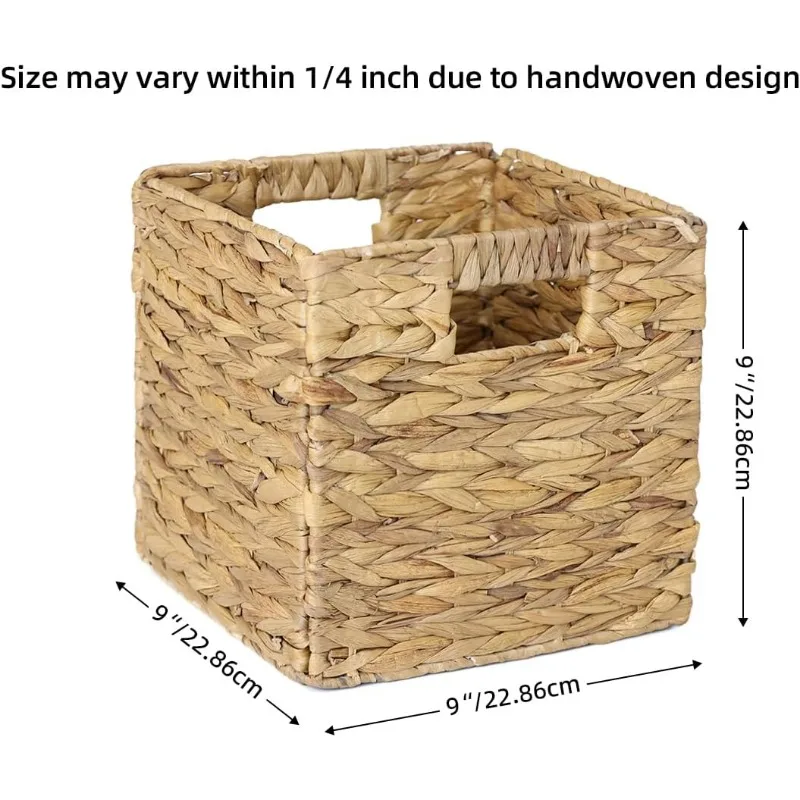
Strategic basket placement transforms laundry room functionality by creating intuitive workflows. The most effective arrangements follow the natural progression of laundry tasks:
Near the entry:
* Place a large hamper or sorter for incoming dirty laundry
* Position small baskets for quick-grab items like dryer sheets
* Install hooks above baskets for hanging items awaiting treatment
By the washing machine:
* Include small baskets for detergent pods, stain removers, and additives
* Position a narrow basket between washer and dryer for lint collection
* Add a designated container for items found in pockets
Around the dryer:
* Place medium baskets to receive clean, warm laundry
* Position specialty containers for items requiring hanging or special handling
* Include a small basket for orphaned socks
On shelving units:
* Arrange baskets by frequency of use, with regular items at eye level
* Use consistent sizing for a tidy appearance
* Implement clear labeling for shared spaces
Maximizing vertical space becomes essential in smaller laundry rooms. Wall-mounted basket systems turn unused wall areas into functional storage while creating visual interest. Inspiration for various laundry room layouts demonstrates how vertical arrangements can accommodate different ceiling heights and architectural features.
Consider ergonomics when determining optimal basket heights. Items used daily should sit between waist and shoulder height to minimize bending and reaching. Heavier baskets belong at waist level or slightly below, while lightweight, infrequently used items can occupy higher positions.
Common Questions About Using Wicker Baskets in Laundry Spaces
Will wicker baskets hold up in humid laundry environments?
Quality wicker and woven baskets can thrive in laundry rooms when properly maintained. For areas with significant humidity, water hyacinth and synthetic wicker options offer the greatest moisture resistance. Allow proper air circulation around baskets and avoid placing them directly against potentially damp walls.
How much weight can woven baskets safely hold?
Weight capacity varies significantly based on material and construction. As a general guideline, rattan and thick water hyacinth baskets typically support 15-25 pounds, making them suitable for heavy detergent bottles or wet towels. Seagrass and jute generally handle 10-15 pounds safely. Always check bottom reinforcement—double-woven or wood-based bottoms indicate higher capacity.
Do natural fiber baskets retain laundry odors?
Unlike plastic, which can absorb and trap odors, properly maintained natural fibers typically resist odor retention. Their breathable nature helps prevent musty smells from developing. For baskets holding soiled laundry, wicker laundry baskets with lids provide the ideal solution—containing immediate odors while allowing airflow that prevents mildew.
Can insects damage woven baskets?
While extremely rare in home environments with regular use, natural fibers can attract pests if left untended in damp, dark conditions. Regular use, cleaning, and proper air circulation eliminate this concern for most households. Periodic inspection of basket corners and undersides helps catch any issues early.
How can I clean wicker baskets that have become soiled?
For light cleaning, use a soft brush to remove dust and debris. For more thorough cleaning, lightly dampen a cloth with water (adding a drop of mild soap for stubborn spots) and wipe the affected area. Always dry the basket thoroughly afterward, using a fan if necessary to eliminate moisture from the weave.
By integrating beautiful, functional wicker and woven baskets throughout your laundry space, you transform a purely utilitarian room into an organized, aesthetically pleasing environment that makes laundry tasks more pleasant. These versatile organizational tools from Tidy Treasure combine timeless appeal with practical functionality—truly organizing life beautifully, one basket at a time.

